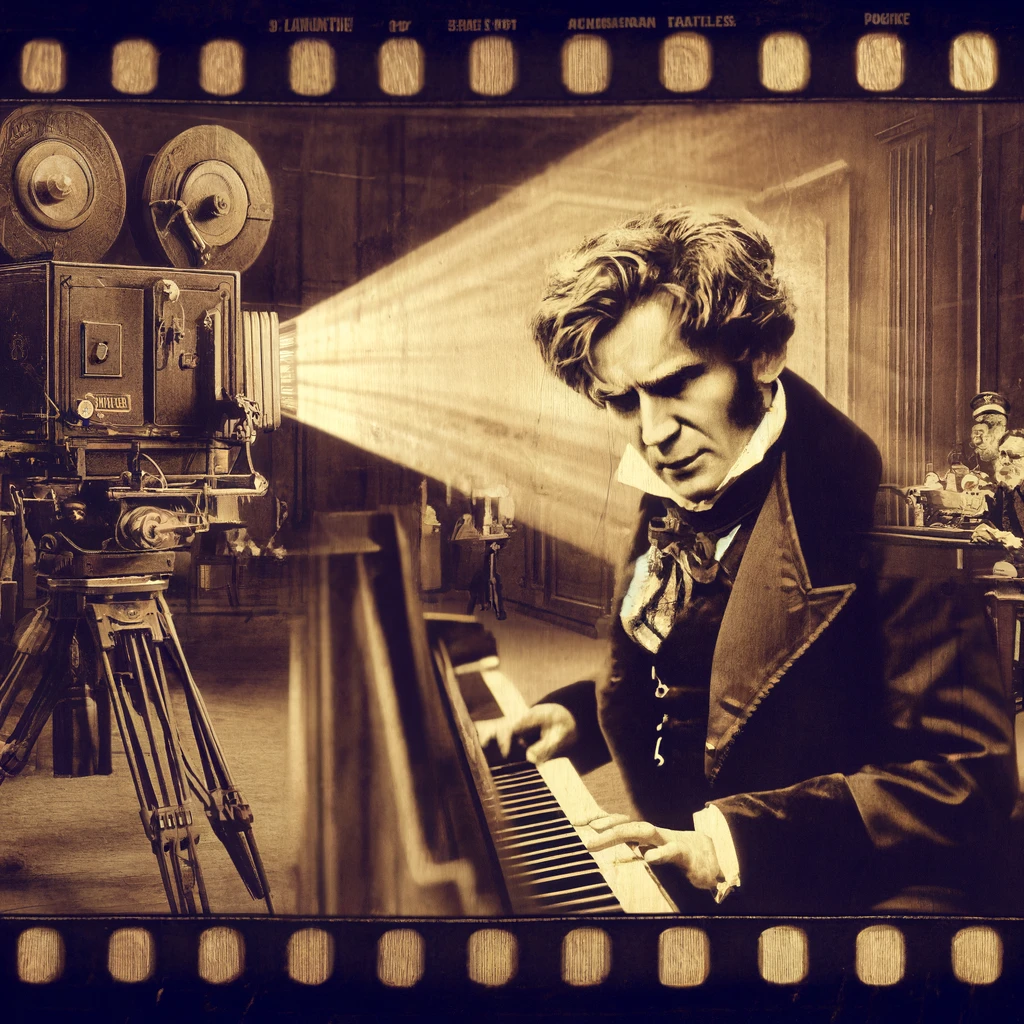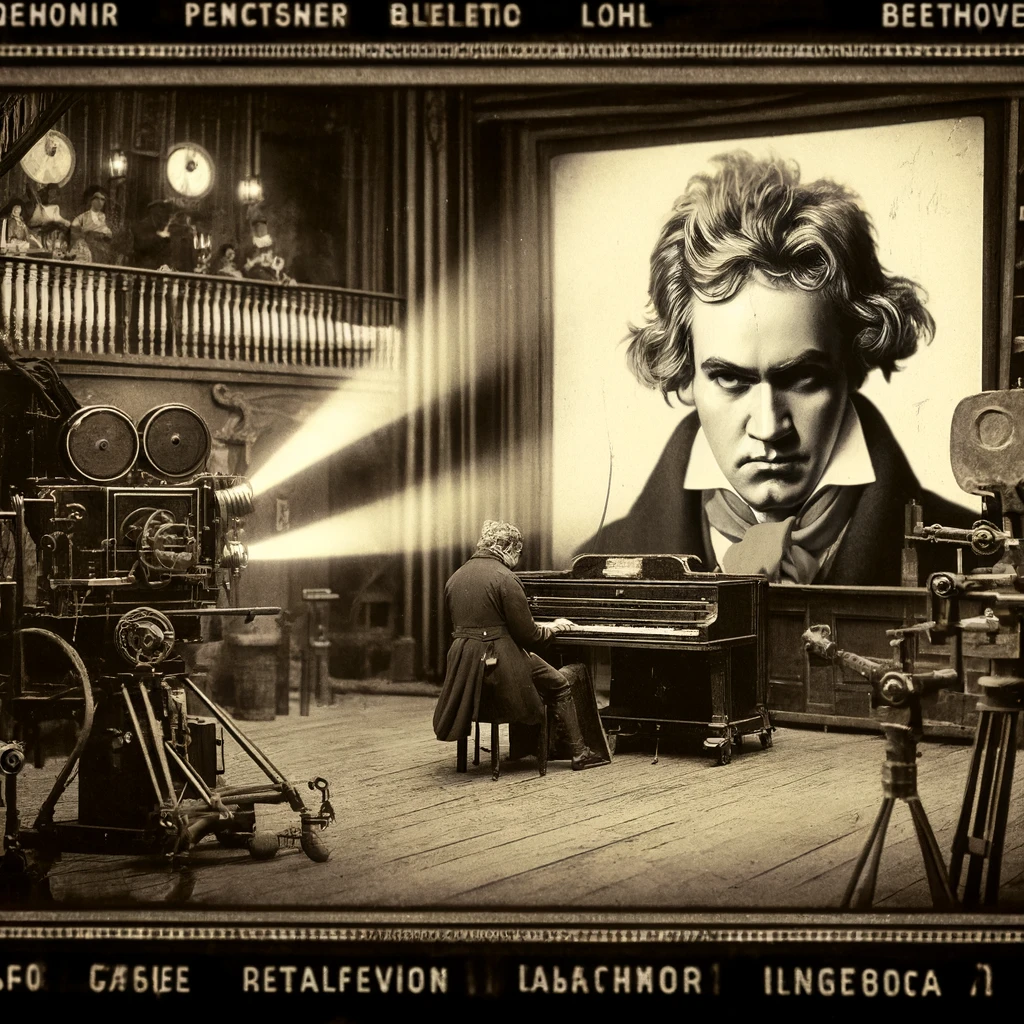
Beethoven in Silent Films: A Historical Overview
Ludwig van Beethoven, a titan of classical music, has left an indelible mark not only on music but also on the cinematic world, particularly during the silent film era. His compositions, laden with emotion and complexity, provided the perfect backdrop for the visual storytelling of early cinema. This article explores Beethoven’s influence on silent films, shedding light on how his music transcended the concert hall to enhance the nascent art form of film.
The Emergence of Beethoven’s Music in Cinema
The silent film era, spanning from the late 1890s to the late 1920s, was a time of experimentation and discovery in filmmaking. Directors and producers sought various means to convey emotion and narrative depth without the use of spoken dialogue. Music, therefore, played a crucial role in silent films, acting as the voice of the film, conveying moods, and underscoring actions.
Beethoven’s compositions, known for their dramatic intensity and emotional depth, were a natural fit for silent cinema. Films during this period often relied on live music to accompany screenings, with pianists, organists, or even small orchestras performing in the theater. Beethoven’s music, particularly his symphonies and piano sonatas, became popular choices for these live performances because they could evoke a wide range of emotions, from joy and tranquility to turmoil and despair.
Key Films and Moments
One notable use of Beethoven’s music in silent cinema was in the 1927 film, “The Life and Loves of Beethoven,” directed by Abel Gance. This biographical film not only depicted Beethoven’s life but also extensively used his music to reflect the emotional landscape of his biography. Gance’s innovative use of cinematic techniques, coupled with Beethoven’s powerful compositions, offered audiences a more profound connection to the story and the character of Beethoven himself.
In other films, snippets of Beethoven’s symphonies were used to enhance scenes of grandeur or conflict. For instance, the opening movements of his famous “Symphony No. 5” and “Symphony No. 9” were popular choices for scenes involving conflict and resolution, respectively. The iconic four-note motif of Symphony No. 5, often interpreted as “fate knocking at the door,” was particularly effective in scenes depicting struggle or tension.
Impact on Audiences and Filmmakers
The inclusion of Beethoven’s music in silent films did more than just enhance the narrative; it also changed how audiences experienced cinema. With Beethoven’s compositions, the films were elevated from mere entertainment to more sophisticated, artful expressions. Audiences were not only visually engaged but also emotionally moved, experiencing the universality of Beethoven’s themes through the lens of cinema.
Filmmakers, too, were influenced by the use of Beethoven’s music. Directors like Gance saw the potential of classical music to add layers of meaning to their films. This practice influenced not just the silent era but also future generations of filmmakers who understood that a film’s score could be as compelling and integral to the storytelling as its visuals.
Beethoven’s Legacy in Modern Cinema
Beethoven’s influence extends beyond the silent film era into modern cinema. His music continues to be a source of inspiration for film scores and is often used to underscore critical moments in contemporary films. The enduring appeal of his work in cinema highlights not only his compositional genius but also his ability to speak to universal human experiences—something that silent film pioneers recognized and capitalized on early in the history of film.
Ludwig van Beethoven’s contributions to the silent film era underscore the timeless nature of his music and its profound impact on the art of filmmaking. His ability to convey deep emotional truths through his compositions made him an invaluable asset to silent filmmakers, who were tasked with telling a story without words. Today, Beethoven’s legacy in film is a testament to the power of music to transcend mediums and continue to touch hearts and minds across different art forms and eras.
This exploration of Beethoven’s role in silent films not only highlights his importance in the history of cinema but also affirms the enduring relevance of his music in artistic expression worldwide. Beethoven, a master of his craft, managed to weave his musical narratives into the very fabric of film history, leaving a legacy that continues to influence and inspire.

The Technical Integration of Beethoven’s Music
During the silent film era, the technical aspect of integrating music into a film was markedly different from today’s practices. Music was not yet embedded within the film itself; instead, it was performed live. This live performance aspect meant that the music was somewhat fluid, with local musicians and conductors adapting Beethoven’s compositions to suit the timing and mood of the film. This practice added a unique, albeit slightly variable, dimension to each screening, as the interpretation of Beethoven’s works could differ depending on the performers.
The transition from live music to recorded scores in the late 1920s marked a significant change in how Beethoven’s music was used in films. With recorded scores, filmmakers gained more control over the musical accompaniment, ensuring consistency across all screenings. This transition allowed for more precise synchronization of music and on-screen action, which enhanced the emotional impact of the music and the storytelling.
Beethoven’s Influence on Film Music Composition
Beethoven’s music, with its clear motifs and emotional depth, provided a blueprint for later film composers on how to use music to enhance cinematic narratives. Composers learned from Beethoven’s ability to develop motifs and themes that could be transformed and reiterated throughout a piece to evoke different emotions and signify various elements of the story.
For instance, the use of leitmotifs, a technique often associated with Richard Wagner but evident in Beethoven’s thematic consistency, became a foundational element in film scoring. A leitmotif—a recurring musical theme associated with a particular idea, character, or place—helps in creating a cohesive auditory experience that parallels the visual narrative of the film.
Educational and Cultural Impacts
The use of Beethoven’s music in silent films also had educational and cultural ramifications. For many viewers, silent films were their first exposure to classical music, and particularly to Beethoven’s compositions. This exposure not only democratized access to classical music but also educated the public about its emotional and aesthetic depths.
Moreover, Beethoven’s music played a role in shaping cultural perceptions of film as a serious art form. By associating cinema with high culture through the use of classical music, filmmakers could elevate the status of their work, attracting a more diverse audience that included both entertainment seekers and art aficionados.
Challenges and Critiques
While Beethoven’s music greatly enhanced the silent film experience, its use was not without challenges and critiques. Some purists argued that the heavy emotional weight of Beethoven’s music could overpower the visual elements of a film, potentially skewing the director’s intended narrative. Others pointed out the potential for cultural disconnects when European classical music was used in films that depicted non-European stories or settings.
Despite these challenges, the overall impact of Beethoven’s music on silent cinema—and indeed on the broader cinematic world—is overwhelmingly positive. His compositions have proven to be versatile and impactful, enriching the cinematic experience and continuing to influence film music composition techniques to this day.
Legacy and Continuation
Today, Beethoven’s music remains a staple in film scores, often used to enhance moments of drama, romance, or conflict. Modern film composers frequently cite Beethoven as an influence, noting his ability to evoke profound emotion and complex, layered atmospheres through his music. The legacy of his work in silent films serves as a reminder of the power of music in cinema and its ability to transcend the boundaries of time and technology.
Conclusion
In retrospect, Beethoven’s integration into silent films was not merely a testament to his enduring appeal but also a pivotal development in cinematic history. His music bridged the gap between the auditory and visual arts, providing filmmakers with a tool to enhance emotional resonance and narrative depth. As we look back on the history of cinema, Beethoven’s contributions continue to resonate, highlighting the profound connection between music and film and the timeless nature of his artistry.